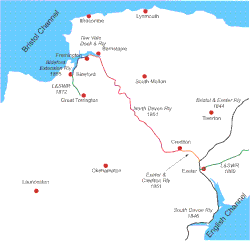North Devon Railway

Map of the North Devon group of railways, with opening dates
|
|
| Track gauge | 4 ft 8 1⁄2 in (1,435 mm) standard gauge |
|---|---|
| Previous gauge | , 7 ft 1⁄4 in (2,140 mm) until 1892 |
The North Devon Railway was a railway company which operated a line from Cowley Bridge Junction, near Exeter, to Bideford in Devon, England, later becoming part of the London and South Western Railway's system. Originally planned as a broad gauge (7 ft 0¼ in, 2,140 mm) feeder to the Bristol & Exeter Railway, it became part of a battle between the broad gauge group and the standard gauge railway interests. In this context, standard gauge lines were often described as narrow gauge.
The original construction in the middle of the nineteenth century was significant in giving rail connection to the important, but remote towns of North Devon that had hitherto relied on the packhorse and coastal shipping. The Exeter to Barnstaple section followed the rivers Yeo and Taw, passing through pleasing countryside, and meandered with the valleys, but passing only very small settlements. It remains open between Exeter and Barnstaple, and passenger trains on the route are branded the Tarka Line for marketing purposes.
The northern extremities turned south to Bideford and Torrington following the coast of the Bristol Channel before turning inland. Part of this section is now a cycleway known as the Tarka Trail.
In the 1830s, it began to be apparent that railways could substantially improve the prospects of connected towns. Most existing transport was by coastal shipping, by rivers and canals, or by pack horse.
In 1831 promoters in Crediton decided that rail connection to a dock on the tidal River Exe at Exeter was needed, and Parliamentary powers were obtained by Act of 23 June 1832. However no construction actually took place and the powers lapsed.
A public meeting at Barnstaple came to a corresponding conclusion for their town, and proposed a railway to Fremington, and to construct a dock there, avoiding the difficult passage of the River Taw to their town. They obtained the Taw Vale Railway and Dock Act on 11 June 1838, but this scheme too resulted in no actual construction. However, there was enough interest to get the Taw Vale Amendment Act on 21 July 1845 extending the powers and authorising certain additional works.
...
Wikipedia
